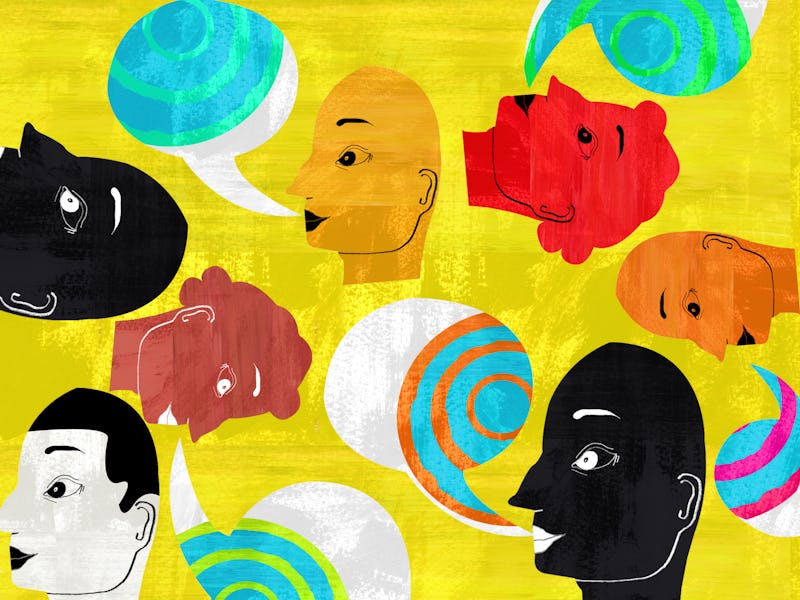How to win arguments and actually change someone's mind
"Pushing people doesn't work."

We all know the feeling. Maybe it’s a heated argument with that crazy uncle at the holiday table, or a frustrating conversation with a colleague who just won’t budge.
At work, and in life, it can be maddening to try to change someone’s mind. That’s because people’s beliefs and opinions, while often rooted in logic and fact, are still wrapped in emotion.
Jonah Berger is a professor of marketing at the Wharton School of Business at the University of Pennsylvania and author of The Catalyst: How to Change Anyone’s Mind. Berger studies how beliefs catch on, stick long term, and how to change them.
“We have a very emotional attachment to things we're doing already. Whether it's the products we're using, the services we engage in, or the ideas we have at the office — we are emotionally attached to them,” Berger tells Inverse. “And so we build logic around those things to support it and look for information that supports our existing beliefs rather than disagrees with it.”
This phenomenon is called confirmation bias, and it’s prevalent in every kind of belief and subsequent choice, from what kind of coffee we drink to our spiritual practice.
Yes, people can get stuck in their ways and beliefs, Berger acknowledges, but he argues it is also possible to change someone’s mind. It just requires rethinking the whole approach.
“Often, we tend to think if we just give people more facts, more figures, more reasons, more information, they'll come around,” Berger explains. “But pushing people doesn't work. When we push people rather than just going along, they often push back.”
This week, Inverse explores how to be an effective catalyst for your workplace, your home, heck, for the world. It’s about identifying why someone is so stubborn to change, then mitigating that barrier rather than pushing people.
“Great catalysts don't push harder or add more energy,” Berger says. “They figure out what the barriers are and they reduce them.”
I’m Ali Pattillo and this is Strategy, a series packed with actionable tips to help you make the most out of your life, career, and finances.
Push and pull — Typically, when we come up against something or someone we want to change, we approach it with force. But often, this aggressive technique makes people defensive and causes them to dig into their beliefs more deeply.
“People don't like being told what to do,” Berger says. “When they feel like someone's persuading them or trying to persuade them, they put up their radar and they ignore, they avoid, or even counter argue against the message.”
“When we push people rather than just going along, they often push back.”
So if this direct approach doesn’t work, what does? To start, Berger says, we have to understand people’s barriers to change — the reasons why they are so cemented in their beliefs.
In his research, the five barriers that come up repeatedly are:
- Reactance: people’s tendency to be defensive and push back when they are pushed.
- Endowment: the amount of time or money someone has sunk into a belief or practice — where they become attached to what they're doing already.
- Distance: when people can’t relate to the other perspective or idea because it’s too much of a “leap” beyond their current belief frameworks.
- Uncertainty: new things or ideas often feel too risky to try or adopt.
- Corroborating evidence: when people simply demand more information or proof to change.
Each of these barriers is something that gets in the way of change, Berger explains. But if we can identify that barrier and mitigate it, “we can change anything.” It’s about pinpointing why people are so stubborn about a certain belief, then addressing the root of that stubbornness.
“The longer we've been doing something, the more expensive something is, the riskier something new is, the more controversial something is, the harder it is to change,” Berger says. And, importantly, the more that someone tells you what you have to do, the less interested you are in doing it, he adds.
To become a better catalyst for change, Berger suggests to:
- Find the gaps. Rather than push or persuade someone, highlight a gap between their attitudes and their actions, and then get them to persuade themselves. For example: If someone is reluctant to wear a mask at work, ask them if they would wear one if their child or elderly parent were in the office. Ask why that same care or concern isn't present with their colleagues?
- Provide a “menu” of choices. Rather than unilaterally force a single solution on others, give people the freedom and autonomy to choose from a few options. This is one way to reduce people’s gut resistance, and again, help them persuade themselves.
- Cut through perceived risks. If people feel like a new idea is controversial or risky, explain your personal experience as to why you think it is more relatable and less extreme than they think.
At the end of the day, having these conversations —successfully— isn’t easy, and it may take repeated attempts. But employing these strategies, instead of pushing someone to bend to your will, can lead to far better outcomes down the line.